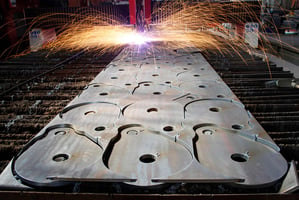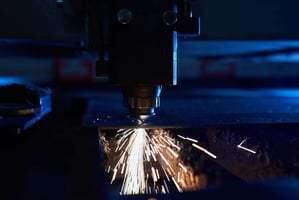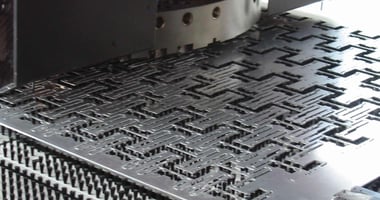Cutting thick plate material presents a unique set of challenges, not least among them is the...
Accelerating CNC Laser Cutting with Fly Cutting
Cutting with CNC lasers is a costly business. While there are expenses that you may think that you can do little about, such as the per unit cost of electricity and gas consumption, nesting software may well be able to deliver a significant saving, depending on the parts that you are cutting.

Imagine an air vent grid for the back panel of a PC. It might comprise of an array of holes – let’s say 10 x 10. The traditional method of cutting each hole would be for the laser to pierce in one corner, cut to the next, change direction 90 degrees, cut, change direction, cut, and then make a final direction change and cut. Then, the laser head would lift, purge and re-pressurise (depending on the technology and machine in use), before moving onto the next hole.
There are several drawbacks to that method. First, each time the laser changes direction it must decelerate to a stop. That’s over 400 times for the above array of holes, before you cut any other elements of the part. There will be at least 100 head lifts, with each one consuming gas. All of these actions add to overall wear and tear on the machine, use more power and more gas. Now consider that this might be one instance of the component out of a thousand that need to be cut. Any savings, however small, all mount up.
If you are cutting thinner materials up to around 1.5mm, then fly cutting, also referred to as grid cutting can significantly reduce runtime, machine movement and consumption of both electricity and gas. Fly cutting is a term used to describe the process of optimising the cutting path by keeping the laser head down and turning the beam on and off while performing all the required cuts in a horizontal line, before moving on to make the vertical cuts. JETCAM Expert nesting software includes JETCut fly cutting, which automatically identifies and applies fly cutting logic to any suitable geometry, without the user having to manually specify what can or cannot be cut this way.
If we return to our grid of 10 x 10 holes, applying fly cutting logic would result in a significantly reduced runtime. Not only would there be a reduction in the directional changes, JETCut applies a radius for each horizontal and vertical turn, so that the laser only slows down rather than stopping completely to change direction. Furthermore, there may be only one head purge, when the laser stops cutting the grid (assuming that other close by geometry is not cut part-way through the grid cutting, as JETCut will apply this logic automatically as part of the optimised sequence of cutting).
When to use fly cutting, and when not to use it.
The obvious benefit is speed – in our own tests we regularly saw a reduction in part runtime of between 25% and 52%. If your laser requires a head purge, then there will be significant savings on the amount of gas consumed – in our example we reduced the gas used because of purges by 99%. Fewer and less abrupt movements of the laser head require less energy to move it, and overall wear and tear is likely to be reduced.
While for some materials it will be a no-brainer to use fly cutting, other materials may be less suitable. Reflective materials such as aluminium don’t lend themselves so well to fly cutting, due to the materials resisting the absorption of the laser.
Depending on the part and material, quality could be either improved or potentially reduced with fly cutting. With ideal materials, fly cutting will often result in sharper internal corners, as traditional cutting methods will apply a very small radius. However, with incorrect settings and/or on thicker materials edge quality can suffer.
With the head down for longer, there is also a greater risk of collision, however this can be mitigated by intelligence within the nesting software. JETCAM Expert optimises the cutting path and includes collision avoidance logic to lift the head based on predetermined rules that aim to minimise machine movement while trying to avoid travel over already cut holes.
Of course, your ability to apply fly cutting logic will be a benefit or drawback, depending on your nesting software. With JETCAM Expert, once JETCut is configured there is no user input required at all – JETCut will be applied automatically where applicable as part of the tooling process. With RCP (Remote Control Processing), applications such as JETCAM Orders Controller or CrossTrack can send hundreds of parts through the CAD import process, automatically tooling each component in a split second.
Machine-specific questions
It’s important to note that not all lasers can perform fly cutting. This will depend very much on the controller, and whether it can accept the required NC code. You should check within your controller manual to see if it’s supported. Existing JETCAM Expert postprocessors can generally be upgraded to support fly cutting, if this has not already been done.
Fly cutting may also be less suited to some CO2 lasers, due to beam quality and wavelength, which can result in less efficient and lower quality cutting. Fibre lasers can cut faster than CO2 and have higher power density, leading to a narrower focal point and therefore more precise cuts. There’s also a potential safety issue, as CO2 lasers run the risk of back reflection when cutting reflective materials, damaging the laser.
JETCAM already has over 1000 postprocessors around the world that can support fly cutting.
Summary
With the drive to remain competitive evermore important, technologies such as JETCut fly cutting allow you to get more throughput with your existing CNC laser, while using less consumables and extending the life of your machine. These are tangible savings that can quickly add up – and these only relate to one feature. The right software can deliver a better nest and NC code, which can not only reduce the runtime and wear and tear on the machine, but also significantly reduce your material scrap, problems in manufacturing such as heat distortion (through heat avoidance logic) and even aiding with unloading (with features such as ‘free corner’ logic).
%20(Custom).jpg?width=1000&height=252&name=JETCAM%20logo%20(glossy%20effect)%20(Custom).jpg)


